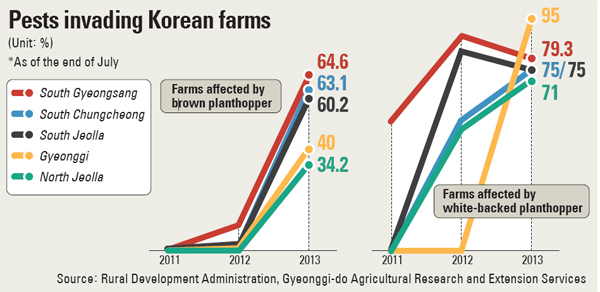Heat wave creates perfect conditions for rice pests

Both types of bugs are major problems for rice crops, feeding on the sap of the plants and leaving them lifeless or dying. The recent hot, humid weather creates the ideal environment for them to breed.
The Rural Development Administration found brown planthoppers in 192 of 342 farms surveyed at the end of July, or 56.1 percent. That’s a thirtyfold increase compared to the same period last year.
Of those, 49 farms, or 14.3 percent, were severely affected with swarms of the bugs and need pest control measures. Even more farms had the white-backed variety of the pest, at 75.1 percent, but only 5.3 percent were afflicted to a serious degree.
“When the scorching summer weather hits the country, it encourages a rise in pests,” said Kim Ki-soo, an official with the Rural Development Administration.
Choi Young-moon, a 78-year-old farmer who grows rice in Tongyeong, South Gyeongsang, has been fighting a losing battle against the bugs. “We’ve already sprayed pesticides every 10 days, but the number of pests just keeps growing,” he said.
The bugs have also spread to Gyeonggi. The provincial government checked 40 farms in the region earlier this month and found that 40 percent harbored brown planthoppers.
“The Gyeonggi area didn’t used to be among the areas affected by the pests,” said Lee Young-soo, a researcher at Gyeonggi-do Agricultural Research and Extension Services.
“But this year, Gyeonggi saw a rise in brown and white-backed planthoppers because of the heat wave that swept the region,” Lee said.
Also affecting crops is the growing presence of bakanae, a rice plant disease caused by a fungus. According to South Jeolla Agricultural Research and Extension Services, 38,800 of a total 171,000 hectares (422,550 acres), or 22.7 percent, are afflicted with the disease. Bakanae causes rice to produce no edible grains or to die completely.
“If the pests take a toll on farms like this, it seems the crop will drastically decrease this year compared to last,” said Shin Gil-ho, a researcher at the South Jeolla agricultural research institute.
BY CHOI MO-RAN [ejpark@joongang.co.kr]










with the Korea JoongAng Daily
To write comments, please log in to one of the accounts.
Standards Board Policy (0/250자)